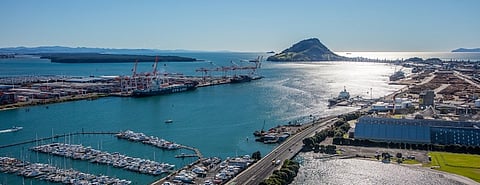

Port of Tauranga has announced relatively stable profitability for the first six months of the 2020 financial year, despite total cargo volumes dipping 4.2 per cent to just under 13.3 million tonnes.
Container numbers increased 3.4 per cent to 642,209 TEU for the six months to December 2019. Transhipment, where cargo is transferred from one ship to another at Tauranga, increased 3.7 per cent.
Port of Tauranga Limited Chair, David Pilkington, said the mid-year results represented another solid financial performance from the company as cargo volumes fluctuated.
"Total trade was down 4.2 per cent, but we managed to increase revenue 1.2 per cent to NZ$154.8 million for the six months," said Mr Pilkington.
"The longer-term outlook remains for cargo growth, particularly in containerised cargo, so our next stage of capacity expansion is already under way," said Mr Pilkington.
Port of Tauranga has just taken delivery of its ninth container crane and will extend its container terminal wharves by up to 220 metres by converting cargo storage land to the south of the existing berths.
Future stages of expansion will be driven by cargo volume growth and will primarily involve rail-mounted electric stacking cranes and additional ship-to-shore cranes.
Port of Tauranga and Tainui Group Holdings plan to form a 50:50 joint venture to develop the Ruakura Inland Port at Hamilton over the next few years. The joint venture will take a 50-year ground lease and aims to open the inland port to coincide with the completion of the nearby Hamilton section of the Waikato Expressway, currently scheduled for the end of 2021.
The 30 hectare Ruakura Inland Port is complemented by a 192 hectare logistics and industrial precinct. The joint venture follows the signing last year of a rail services agreement enabling Port of Tauranga cargo trains to call at the freight hub.
Port of Tauranga's senior executives continue to work with the Ministry of Transport and other upper North Island ports on a report to Cabinet due in May. The report will examine the recommendation by the Upper North Island Supply Chain Working Group that Ports of Auckland's cargoes be shifted to Northport in Whangarei.
Port of Tauranga said it has the space and transport networks available to accommodate Auckland's vehicle imports and other bulk cargoes. The port's container terminal also has future capacity of up to 2.8 to 3.0 million TEU with investment in stacking cranes and other technology.
Despite the increase in containerised trade, global commodity cycles have seen exported cargo decrease 2.6 per cent to 8.6 million tonnes. The volume of imported goods handled by Port of Tauranga decreased 6.7 per cent to nearly 4.7 million tonnes over the six month period.
Log exports were down 8.4 per cent on the previous corresponding period, to 3.4 million tonnes, following a period of lower international prices and demand. However, relative market share has continued to strengthen when compared with other New Zealand ports. Sawn timber exports decreased 3.3 per cent in volume, pulp and paper exports increased 8.4 per cent in volume.
Dairy product exports increased 6.3 per cent to 1.2 million tonnes for the six month period. Frozen meat exports increased 10.8 per cent in volume.
Imported fertilisers and dairy stock feed supplements decreased by 11.6 per cent and 18.4 per cent respectively. Grain imports increased 15.2 per cent in volume. Imported oil products decreased 8.1 per cent.
Ship visits decreased by 7.4 per cent, from 842 to 780 for the period.
In addition to the expansion of the container terminal, Port of Tauranga has acquired cargo storage space at the Mount Maunganui wharves. The port has acquired a cold store, previously occupied by Fonterra. The 2.4-hectare warehouse will be converted into dry cargo storage suitable for vehicle imports and other bulk cargoes.
As well as the new container crane, Port of Tauranga has taken delivery of the first of seven new straddle carriers, three of which are hybrid models that are expected to be 30 per cent to 40 per cent more fuel efficient than the current diesel-electric models.
As the port continues its efforts to become more fuel efficient and reduce carbon emissions, it has added another three electric or hybrid vehicles to its light vehicle fleet. The port sources biodiesel for its other operational equipment.
